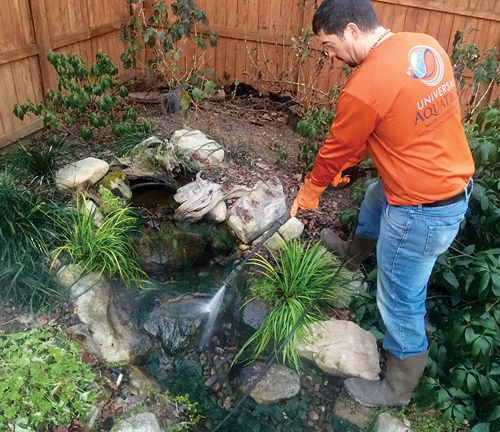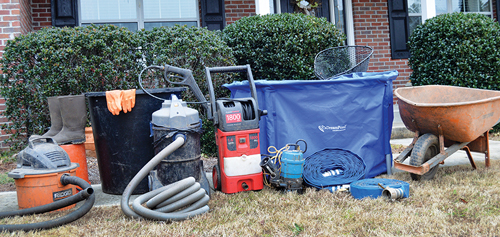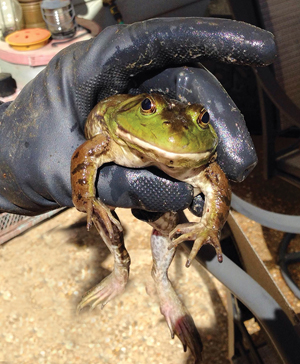
Tis the season to begin another vigorous attack on dirty ponds. Pond cleanout season is quickly approaching, and the team at Universal Aquatics in Atlanta is getting ready for another great one. Here are a few tips to help make the most out of your spring pond-cleaning season.
The Name of the Game: Speed & Efficiency
By maximizing both speed and efficiency, your team will have the ability to service more customers in a shorter time frame. Well-trained team members following set pond-cleaning procedures is a must in order to maximize efficiency. Having the right equipment is also necessary in order to prepare your team for a winning pond cleanout season.
- Start draining the pond immediately.
- Recycle as much healthy pond water as possible. This is a huge time saver. If the pond water is not in good shape and cannot be recycled, start filling your holding tanks with fresh water. Use this water to fill the pond later.
Always use two hoses from the customer’s house if possible while cleaning the system. Two water sources will mean better efficiency. - Add a Y-splitter on the pressure washer line with 10 to 15 feet of hose. This way, only one water source is tied up, with one person rinsing the pond and the other pressure washing.
- After recycling all the desired pond water and removing all the fish, use the discharge hose from the main cleanout pump to rinse the muck out of the stream, pond walls and filters using high-pressure pond water. The entire system rinses much more quickly that way than with a standard garden hose. Not to mention the bacteria-related benefits!
- Collect all the pond debris with fine-mesh fish nets or buckets and place it in wheelbarrows. If possible, distribute the waste around shrubs at the customer’s house. Our team makes great efforts not to remove any pond debris from the site.
- If there is an excess amount of sludge in the pond, it can be diluted and simply pumped out with a heavy-duty pond cleanout pump.
- When refilling the pond, place the refill lines on a flat stone. Try to avoid placing the refill hose in gravel, if possible. Also, it is helpful to keep the hose in one spot throughout this process. This will keep the gravel from clouding up the water. Our team will stay until small-to-medium ponds are completely refilled. For larger ponds, our customers will typically refill them after we finish, turning on the pump themselves.
- Divide and conquer. Always multitask, thinking several steps ahead during the cleanout process.
Acclimating Fish

Fish acclimation takes time, and floating fish for a few minutes in a plastic bag simply doesn’t cut it. Change is often challenging for most people I know, and fish are no exception. In the professional aquarium world, a general rule of thumb for successful fish acclimation is: half old water, half new water. Rinse and repeat three times or so over the course of an hour, and voila —“ happy, healthy fish. It is no different in the pond world. More recycled, clean pond water means happier and healthier koi and goldfish.
Scheduling Appointments
Scheduling appointments for koi pond cleanouts can be approached in a couple of different ways. If appointments are scheduled when a customer is present, the job may take longer, but the customer can usually fill the pond for you. Plus, you’ll have the ability to make an upsell or two. If the customer is not there, you can work much faster, but you may have to stay longer to fill the pond. But, during the time it takes the pond to fill, you can organize your truck and trailer.
Planting Sales Seeds
Pond cleanout season is one of the best times to plant seeds for future company sales. Take the time to develop ideas and potential plans for upgrades. By spending one-on-one time with your customer in a no-pressure setting, seeds for future sales can be planted. Nothing says, “no pressure” like chatting away pondside, covered in mucky pond scum. Plant those seeds in the spring and watch them grow throughout the season.
Building Relationships

In this business, we are nothing without our customers. Spend some extra time with them during this spring season. By just spending a few extra minutes making conversation with our customers about topics other than “pond talk,” we can build relationships that last a lifetime. By developing better, long-lasting relationships with our customers, we can stay in business and count on success in the years ahead.
Keys to Success
The key to successful pond cleanouts is to service the pond as quickly and efficiently as possible without sacrificing team safety, quality and overall fish health. Develop what works best for your team and stick with it. There may be a bit of tweaking that needs to be done throughout the season, but these cleanout tips are sure to save you time and energy as you wade through the muck and sludge to a more efficient pond cleaning program.
The Basics: Pond Cleanout 101
• Remove all water from the pond.
• Gently remove the fish and place them into holding containers.
• Remove most of the debris from the feature.
• Pressure wash the pond, stream and/or waterfall.
• Thin out pond plants if necessary.
• Clean all filter pads, skimmer and pump(s) as needed.
• Check the lighting system.
• Check the pump(s) for proper water flow.
• Make necessary minor adjustments to any stone that has shifted.
• Add water conditioner and bacteria to the newly filling system.
• Reintroduce the fish to their new home.
Supplies You’ll Need:
• Cleanout pump(s) with 2-inch discharge hose(s)
• Garden hoses
• Fish-holding tank(s) with net cover
• Air pump for fish
• Pond vacuum
• Shop vacuum
• Pressure washer
• Wheelbarrow
• Buckets
• Trash bags
• Extension cords
• Power strips
• Fish nets
• Debris/sludge net
• Boots/waders
• Gloves
• Dechlorinator
• Bacteria
• Filter pads
• Upsell items (lights, ionizer, chlorine remover, fish food, algae treatment products, etc.)

